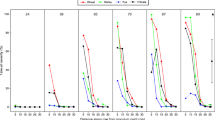Abstract
Fusarium oxysporum colonized soybean [Glycine max (L.) Merrill cv. Essex] cotyledons 1 day after planting in a naturally infested soil and was present in 25% of tissue segments after 4 days. Both F. solani and F. oxysporum colonized the lower hypocotyl and emerging roots 2 and 3 days after planting, respectively. After 4 days, both fungi were found colonizing the elongating, upper portion of the hypocotyl, but the root tip remained free of the two fungi. The hypocotyl-root transition zone had the highest frequency of colonization (20–28% of 2 mm tissue segments) by each species at 4 days. F. solani had higher inoculum efficiencies for colonization than F. oxysporum. Tissue pasteurization tests indicated most early colonization is confined to the outer portions of tissues. The relative frequency and pattern of isolation of F. oxysporum and F. solani from lesions paralleled that of early colonization results, but only a small portion of hypocotyl and root colonization sites developed into lesions. These results support the hypothesis that non-pathogenic and pathogenic F. oxysporum and F. solani strains are primary and frequent colonizers of soybean tissues. Non-pathogenic isolates may have potential for biocontrol.
Similar content being viewed by others
References
Farias G M and Griffin G J 1989 Roles of Fusarium oxysporum and F. solani in Essex disease of soybean in Virginia. Plant Disease 73, 38–42.
Ferrant N P and Carroll R B 1981 Fusarium wilt of soybean in Delaware. Plant Disease 65, 596–599.
Griffin G J 1969 Fusarium oxysporum and Aspergillus flavus spore germination in the rhizosphere of peanut. Physopathology 59, 1214–1218.
Griffin G J and Baker R 1990 Population dynamics of soilborne pathogens in relation to infectious inoculum. In Soil Solarization. Eds. Y Katan and J. Devay. CRC Press, Baca Raton, FL. (In press.)
Klag N G, Papaviza G C, Bean G A and Kantzes J C 1978 Root rot of soybeans in Maryland. Plant Dis. Reptr. 62. 235–239.
Komada H 1975 Development of a selective medium for quantitative isolation of Fusarium oxysporum from natural soil. Rev. Plant Prot. Res. 8, 114–125.
Kommedhal T and Windels C E 1979 Fungi: Pathogens or host dominance in disease. In Ecology of Root Pathogen. Eds. S V Krupa and Y R Dommergues. pp 1–82. Elsevier Scientific Pub. Co. Amsterdam, The Netherlands.
Nelson P E, Tousson T A and Marsas W F O 1983 Fusarium species. The Pennsylvania State University Press, University Park. 193 p.
Nyvall R F 1976 Colonization of soybean by species of Fusarium. Mycologia 68, 1002–1010.
Park D 1959 Some aspects of the biology of Fusarium oxysporum Schl. in soil. Ann. Bot. 23, 35–49.
Park C S, Paulitz T C and Baker R 1988 Biocontrol of Fusarium wilt of cucumber resulting from interaction between Pseudomonas putida and non-pathogenic isolates of Fusarium oxysporum. Phytopathology 78, 190–194.
Parkinson D 1965 The development of fungi in the root region of crop plants. In Plant Microbe Relationships. Eds. J Macura and V Vancura. pp 69–75. Publishing House of the Czechoslovak Academy of Science. Prague.
Parkinson D 1967 Soil microorganisms and plant roots. In Soil Biology. Eds. A Burgues and F Raw. pp 449–487. Academic Press, New York.
Parkinson D and Pearson R 1967 Studies of fungi in the root region. VII. Comparative ability of sterile dark fungi. Plant and Soil 27, 120–130.
Parkinson D, Taylor G S and Pearson R 1963 Studies on fungi in the root region. I. The development of fungi on young roots. Plant and Soil 19, 332–349.
Paulitz T C, Park C S and Baker R 1987 Biological control of Fusarium wilt of cucumber with non-pathogenic isolates of Fusarium oxysporum. Can. J. Microbiol. 33, 349–353.
Schneider R W 1984 Effects of non-pathogenic strains of Fusarium oxysporum on celery root infection by F. oxysporum f. sp. apii and a novel use of the Linewater-Burk double reciprocal plot technique. Phytopathology 74, 646–653.
Taylor G S and Parkinson D 1961 The growth of saprophytic fungi on root surfaces. Plant and Soil 15, 261–267.
Tommimatsu G S and Griffin G J 1988 Infection level and extent of colonization by Cylindrocladium crotalariae of roots of Cylindrocladium black rot-susceptible and resistent peanut cultivar in naturally infested soil. Can. J. Plant Pathol. 10, 11–14.
Warren H L and Kommedahl T 1973 Fusarium species in roots and soil associated with monoculture of soybean in Minnesota. Plant Dis. Rep. 57, 912–914.
Author information
Authors and Affiliations
Rights and permissions
About this article
Cite this article
Farias, G.M., Griffin, G.J. Extent and pattern of early soybean seedling colonization by Fusarium oxysporum and F. solani in naturally infested soil. Plant Soil 123, 59–65 (1990). https://doi.org/10.1007/BF00009926
Received:
Issue Date:
DOI: https://doi.org/10.1007/BF00009926




